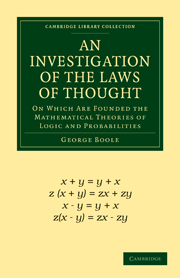 An Investigation of the Laws of Thought
An Investigation of the Laws of Thought Published online by Cambridge University Press: 05 November 2011
ON ELIMINATION.
1. In the examples discussed in the last chapter, all the elements of the original premiss re-appeared in the conclusion, only in a different order, and with a different connexion. But it more usually happens in common reasoning, and especially when we have more than one premiss, that some of the elements are required not to appear in the conclusion. Such elements, or, as they are commonly called, “middle terms,” may be considered as introduced into the original propositions only for the sake of that connexion which they assist to establish among the other elements, which are alone designed to enter into the expression of the conclusion.
2. Respecting such intermediate elements, or middle terms, some erroneous notions prevail. It is a general opinion, to which, however, the examples contained in the last chapter furnish a contradiction, that inference consists peculiarly in the elimination of such terms, and that the elementary type of this process is exhibited in the elimination of one middle term from two premises, so as to produce a single resulting conclusion into which that term does not enter. Hence it is commonly held, that syllogism is the basis, or else the common type, of all inference, which may thus, however complex its form and structure, be resolved into a series of syllogisms. The propriety of this view will be considered in a subsequent chapter.
To save this book to your Kindle, first ensure no-reply@cambridge.org is added to your Approved Personal Document E-mail List under your Personal Document Settings on the Manage Your Content and Devices page of your Amazon account. Then enter the ‘name’ part of your Kindle email address below. Find out more about saving to your Kindle.
Note you can select to save to either the @free.kindle.com or @kindle.com variations. ‘@free.kindle.com’ emails are free but can only be saved to your device when it is connected to wi-fi. ‘@kindle.com’ emails can be delivered even when you are not connected to wi-fi, but note that service fees apply.
Find out more about the Kindle Personal Document Service.
To save content items to your account, please confirm that you agree to abide by our usage policies. If this is the first time you use this feature, you will be asked to authorise Cambridge Core to connect with your account. Find out more about saving content to Dropbox.
To save content items to your account, please confirm that you agree to abide by our usage policies. If this is the first time you use this feature, you will be asked to authorise Cambridge Core to connect with your account. Find out more about saving content to Google Drive.